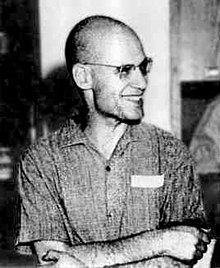
Back ألكسندر غروتينديك Arabic الكسندر جروتينديك ARZ আলেকজেণ্ডাৰ গ্ৰথেণ্ডিক Assamese Alexander Grothendieck AST الکساندر قروتندیک AZB Аляксандр Гратэндык Byelorussian Александър Гротендик Bulgarian Alexander Grothendieck Catalan Alexander Grothendieck Czech Alexander Grothendieck Danish
Alexander Grothendieck | |
|---|---|
 Alexander Grothendieck in Montreal, 1970 | |
| Born | 28 March 1928 |
| Died | 13 November 2014 (aged 86) Saint-Lizier, Ariège, France |
| Nationality | |
| Alma mater | |
| Known for | Renewing algebraic geometry and synthesis between it and number theory and topology List of things named after Alexander Grothendieck |
| Awards |
|
| Scientific career | |
| Fields | Mathematics – functional analysis, algebraic geometry, homological algebra |
| Institutions | |
| Thesis | Produits tensoriels topologiques et espaces nucléaires (1953) |
| Doctoral advisors | |
| Doctoral students | |
Alexander Grothendieck (/ˈɡroʊtəndiːk/; German pronunciation: [ˌalɛˈksandɐ ˈɡʁoːtn̩ˌdiːk] ; French: [ɡʁɔtɛndik]; 28 March 1928 – 13 November 2014) was a German-born mathematician who became the leading figure in the creation of modern algebraic geometry.[7][8] His research extended the scope of the field and added elements of commutative algebra, homological algebra, sheaf theory, and category theory to its foundations, while his so-called "relative" perspective led to revolutionary advances in many areas of pure mathematics.[7][9] He is considered by many to be the greatest mathematician of the twentieth century.[10][11]
Grothendieck began his productive and public career as a mathematician in 1949. In 1958, he was appointed a research professor at the Institut des hautes études scientifiques (IHÉS) and remained there until 1970, when, driven by personal and political convictions, he left following a dispute over military funding. He received the Fields Medal in 1966 for advances in algebraic geometry, homological algebra, and K-theory.[12] He later became professor at the University of Montpellier[1] and, while still producing relevant mathematical work, he withdrew from the mathematical community and devoted himself to political and religious pursuits (first Buddhism and later, a more Catholic Christian vision).[13] In 1991, he moved to the French village of Lasserre in the Pyrenees, where he lived in seclusion, still working on mathematics and his philosophical and religious thoughts until his death in 2014.[14]
- ^ a b Scharlau 2008.
- ^ Cartier et al. 2007, p. 7.
- ^ Cartier 2004.
- ^ a b Douroux 2012.
- ^ Cartier 2004, p. 10, footnote 12.
- ^ Kleinert 2007.
- ^ a b Jackson 2004b.
- ^ Bruce Weber; Julie Rehmeyer (14 November 2014). "Alexander Grothendieck, Math Enigma, Dies at 86". The New York Times. Archived from the original on 1 January 2022.
- ^ Mumford, David; Tate, John (2015). "Alexander Grothendieck (1928–2014) Mathematician who rebuilt algebraic geometry". Nature. 517 (7534): 272. Bibcode:2015Natur.517..272M. doi:10.1038/517272a. ISSN 0028-0836. PMID 25592527.
- ^ "Guardian obituary". Independent.co.uk.
- ^ Cite error: The named reference
obitwas invoked but never defined (see the help page). - ^ "Fields Medals 1966". mathunion.org. Archived from the original on 22 March 2019. Retrieved 5 January 2022.
- ^ Scharlau, Winfried. "Who is Alexander Grothendieck? Anarchy, Mathematics, Spirituality, Solitude" (PDF). Archived (PDF) from the original on 9 October 2022.
- ^ Ruelle 2007, p. 40.